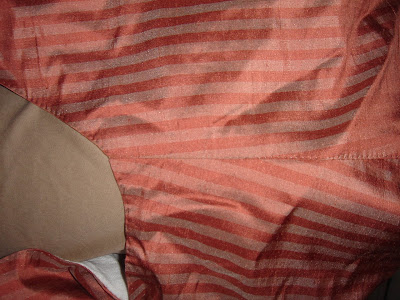I'm going to try to cover some of the basic stitches and their uses. There are so many other stitches and I really recommend purchasing Kannik's Lady's Guide to Plain Sewing books. I'm mainly covering the types that I'm going to be mentioning a lot. I noticed that one of the hardest things to find information on is what stitch is proper to use where. I'll try to mention a few of the most common uses and they'll come up later in instructions.
One of the best tips I have gotten about 18th century hand sewing is that today we stitch a seam and open it up. Back then, they would most often fold the seams then stitch. I'll explain it more further on.
Running Stitch
The most basic of stitches. Up, down, up, down. That's it. On average, there would be about 8-10 stitches per inch. That depends mostly on how much work the seam will get. If you're doing a side seam for a petticoat, you can run a little longer. This can be used in open seams or as a basting stitch. Yes, I did just say they folded then stitched, but some seams like petticoat sides or center back on some jackets couldn't be. However, in both cases, I'd recommend a back stitch or a combination stitch for strength.
Back Stitch
Probably the most useful stitch to learn. You come up a stitch length past your last stitch and then go down meeting with that last stitch. It creates a very strong seam. Again, about 8-10 per inch on average. If you do a few running stitches, then one back stitch it's known as a combination stitch. Combinations are great for petticoat side seams where you want speed and strength. Back stitches can easily create open seams or lapped seams. For lapped seams you spread out the stitch showing a short "prick" on the outside and a longer stitch inside. Fold over the seam allowance on one piece and lay it on top of the other then stitch near the edge (1/8"). If you're doing a lined piece you can fold the outer layer on one side, lay it on both layers from the other side, stitch, then fold the last lining piece over to hide the edges. I'll show examples when I get to jackets. The spread out back stitch can also be used along edges to keep them from rolling, attach skirts on gowns, or stitch on trim and robings.
Point a Rabattre/whip stitch/plain hem
Whatever you call it, this stitch can be used just about anywhere. You can use it to hem, roll edges, and stitch in linings. I show two uses below, the first as a way to stitch a lining in at the edge and the second as a rolled edge. I'll expand on the lining use at a later point. Keep in mind this stitch is small as well, only showing a small prick on the outer side.
If you roll two layers together and make sure to go through both on the prick stitch then it's a Mantua Maker's seam which is a fast way to seam and finish edges at the same time!
If you do a back or running stitch with the two edges off set, fold over the allowance twice then whip it down to one side it's a flat felled seam.
There are many more combinations of these three stitches as there are many other stitches. Again, I recommend the Lady's Guides. They're inexpensive and probably the most useful books you will own if you want to hand stitch your clothing. I'll be referencing the use of these stitches in all of my instructions.






































